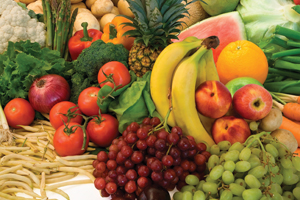
Research is showing that a diet rich in fruits and vegetables can actually outweigh the negative consequences of pesticide exposure.
by Joanne Henning Tedescco —
Your mother always told you to eat your fruits and vegetables, but lately you have been worrying about all the pesticides. The good news is that research is showing that a diet rich in fruits and vegetables can actually outweigh the negative consequences of pesticide exposure.
That being said, some fruits and vegetables are lower in toxic pesticides than others. This list will help you shop more wisely if you cannot afford to buy all organic produce.
The Environmental Working Group (EWG) cleverly calls the following 12 fruits and vegetables the “dirty dozen,” based on their high levels of pesticides when compared to other produce. If possible, when you purchase items from the dirty dozen — apples, celery, strawberries, peaches, spinach, nectarines, grapes, sweet bell peppers, potatoes, blueberries, lettuce and kale/collard greens — make sure they are organic.
The following 15 produce items are known by the EWG as the “clean 15.” They are the lowest in toxic pesticides; so when you shop for non-organic produce, these would be the best ones to buy. They include onions, sweet corn, pineapples, avocado, asparagus, sweet peas, mangoes, eggplant, cantaloupe, kiwi, cabbage, watermelon, sweet potatoes, grapefruit and mushrooms.
Eating foods from the clean 15 will lower your pesticide exposure by 92 percent when compared with the dirty dozen. By choosing your five fruits and vegetables a day from the clean 15, you will consume fewer than two pesticides per day. But if you consume five fruits and vegetables a day from the dirty dozen, you can ingest as many as 14 different pesticides every day.
This information is based on analyses conducted by the USDA and FDA of 51,000 tests for pesticides performed on 53 popular fruits and vegetables between 2001 and 2009. The fruits and vegetables in the tests were rinsed and peeled so that they would be similar to the conditions in which they are normally consumed.
Source: www.environmentalworkinggroup.com.
Reprinted from AzNetNews, Volume 32, Number 1, February/March 2013.





March 29, 2013
Chemical and Toxic Exposure, February/March 2013 Issue, Food, Nutrition and Diet, Fruits and Vegetables, Organic